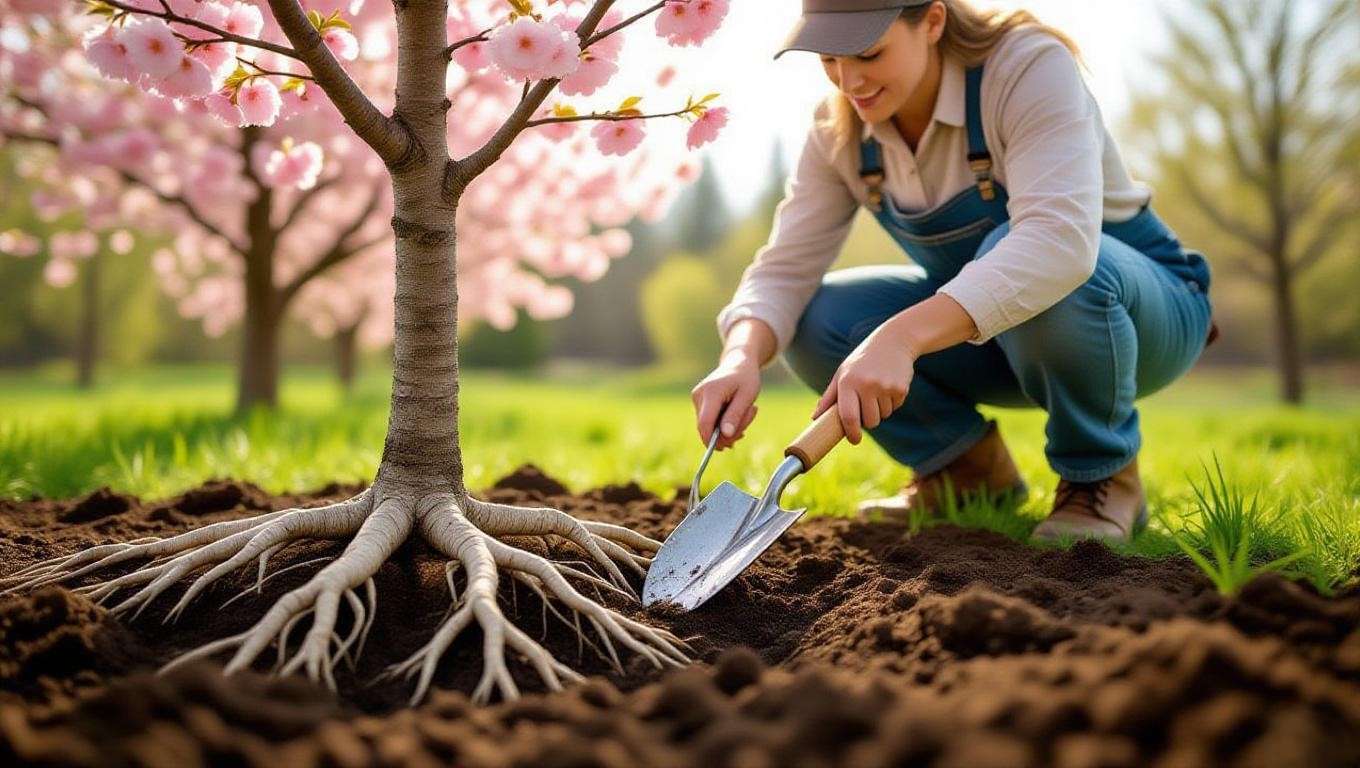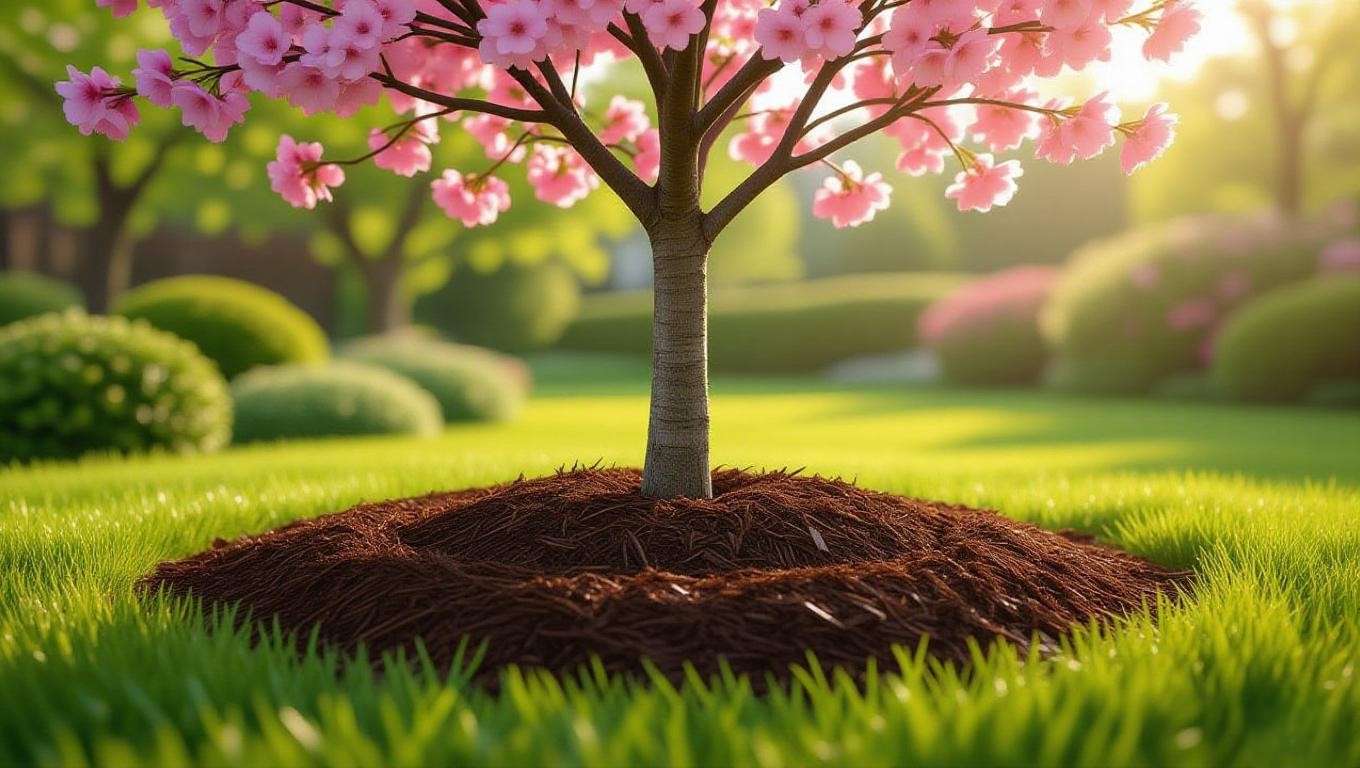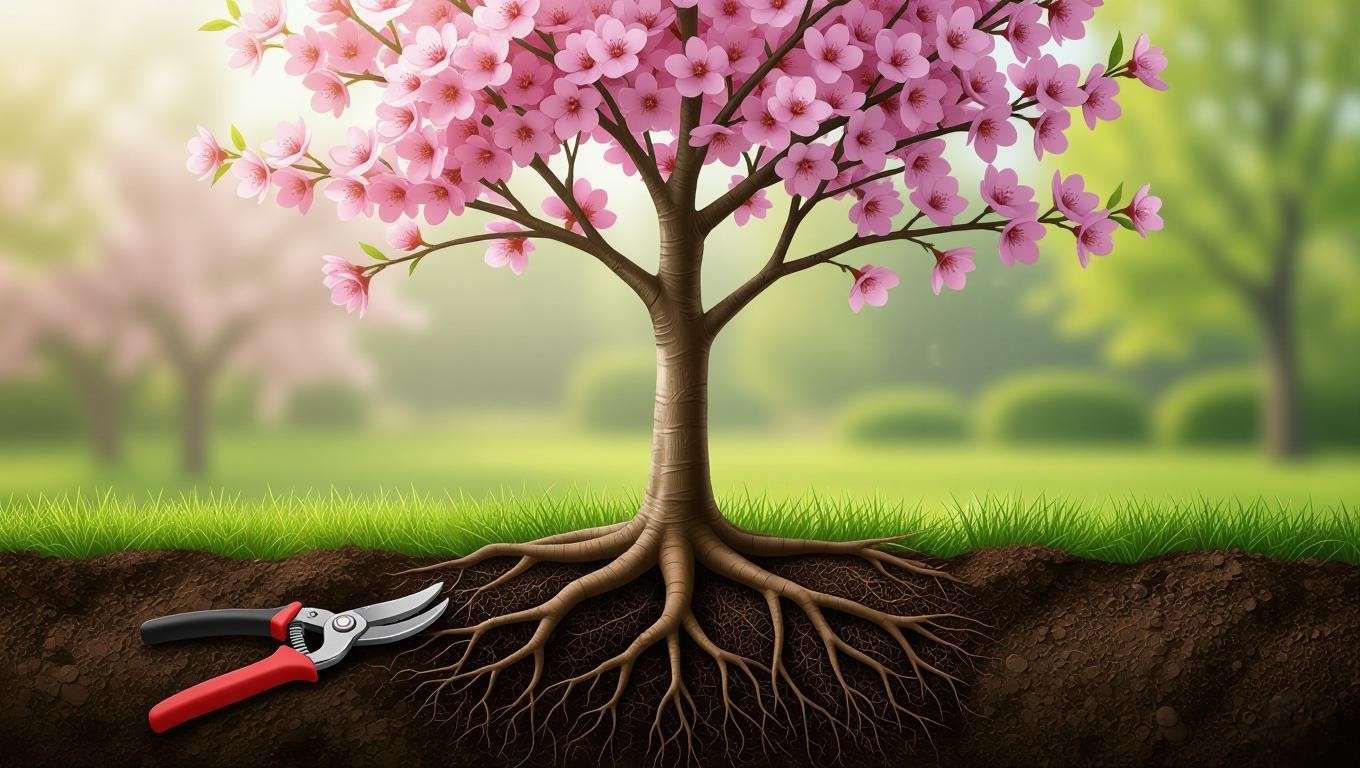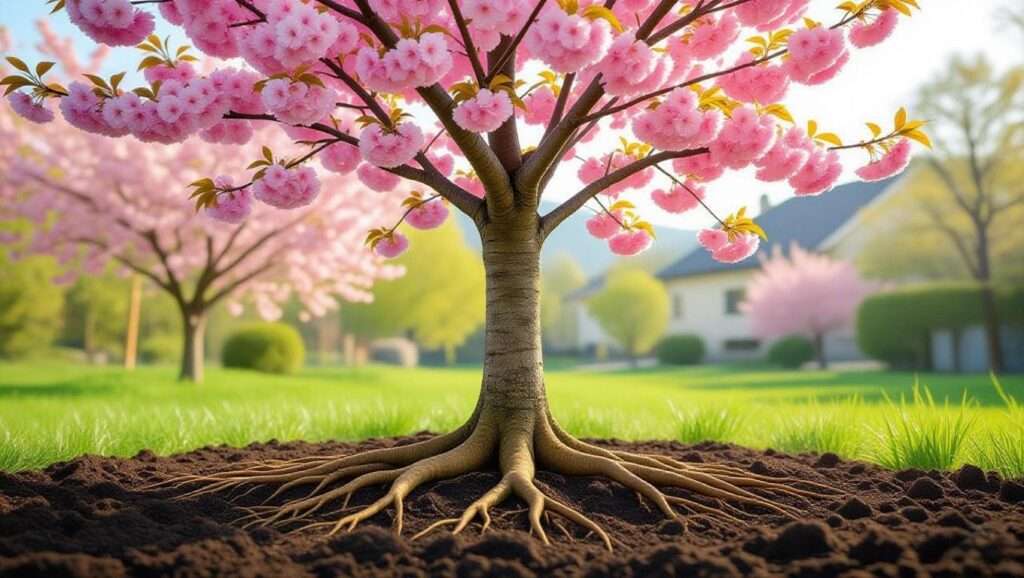Picture this: a cherry tree bursting with vibrant blossoms and juicy, ruby-red cherries in your backyard. 🍒 Now, imagine the secret to this splendor lies hidden beneath the soil. Learning how to maintain healthy cherry tree roots in your garden is the key to unlocking this vision. Healthy roots are the unsung heroes of a thriving cherry tree, anchoring it firmly while absorbing vital nutrients and water. Without strong roots, your tree may struggle, producing lackluster fruit or succumbing to disease. In this comprehensive guide, you’ll discover seven expert-backed tips to nurture your cherry tree’s roots, ensuring lush growth and bountiful harvests. Drawing on decades of horticultural expertise and insights from leading agricultural research, this article will empower you to cultivate a flourishing cherry tree. 🌱
1. Understanding Cherry Tree Roots: The Foundation of Growth 🌱
Why Healthy Roots Matter for Cherry Trees
Roots are the lifeline of any cherry tree, serving three critical functions: anchoring the tree, absorbing water, and delivering nutrients to support growth and fruit production. Healthy roots ensure your tree withstands storms, resists diseases, and produces those delicious cherries you love. Weak or damaged roots, on the other hand, can lead to stunted growth, poor fruit yield, or even tree death. According to a study by the University of California Agriculture and Natural Resources, robust root systems directly correlate with higher fruit quality in cherry orchards. By prioritizing root health, you’re investing in your tree’s long-term vitality. 🌳
Anatomy of Cherry Tree Roots
Cherry trees typically develop a combination of a central taproot and a network of fibrous feeder roots. The taproot grows deep to provide stability, while feeder roots spread horizontally near the soil surface to absorb water and nutrients. Understanding this structure helps you make informed care decisions. For instance, compacted or waterlogged soil can suffocate feeder roots, while poor drainage can rot the taproot. Visualizing this system—perhaps with a diagram of a cherry tree’s root structure—can clarify how soil conditions influence growth. Aim for loose, well-aerated soil to support both root types. 🌍

2. Assessing Your Cherry Tree’s Root Health 🔍
Signs of Healthy vs. Unhealthy Roots
Healthy cherry tree roots are firm, white, and spread evenly through the soil. You might notice vigorous growth, lush foliage, and consistent fruiting as signs of root vitality. Conversely, unhealthy roots often appear brown, mushy, or sparse, leading to symptoms like wilting leaves, yellowing foliage, or stunted growth. To inspect roots safely, gently dig around the tree’s drip line (the area beneath the canopy’s outer edge) using a hand trowel. Avoid cutting major roots, as this can stress the tree. Regular checks help catch issues early. 🕵️♀️
Tip: If you’re unsure about root health, consult a local arborist for a professional assessment.

Common Root Problems in Cherry Trees
Root rot, often caused by fungi like Phytophthora, is a common threat, especially in poorly drained soils. Symptoms include soggy, discolored roots and wilting leaves despite adequate watering. Compacted soil, another culprit, restricts root expansion and nutrient uptake, leading to weak growth. For example, a gardener in Oregon once noticed her cherry tree’s leaves yellowing despite regular care. After inspecting the roots, she discovered root rot caused by overwatering. By improving drainage and applying fungicides, she saved the tree. Regular monitoring and proactive care can prevent such issues. 🚨
3. Tip 1: Choose the Right Soil for Optimal Root Growth 🌍
Ideal Soil Conditions for Cherry Tree Roots
Cherry trees thrive in well-draining, loamy soil with a pH between 6.0 and 7.0. This soil type allows roots to breathe while retaining enough moisture for nutrient absorption. Compacted or clay-heavy soils can choke roots, while sandy soils may drain too quickly, starving them of water. Adding organic matter, like compost, improves soil structure and fertility. According to Cornell University’s horticulture department, testing soil pH and nutrient levels before planting is crucial for root health. A simple soil test kit from your local garden center can provide actionable insights. 🌱
How to Prepare Soil for Planting
Before planting your cherry tree, prepare the soil to create an ideal environment for root growth. Follow these steps:
- Test the soil: Use a pH test kit to check acidity and nutrient levels.
- Amend the soil: Mix in compost or aged manure to boost organic matter.
- Loosen the soil: Dig a planting hole twice as wide as the root ball to encourage root spread.
- Check drainage: Ensure water doesn’t pool in the hole after rain.
Avoid heavy clay soils, as they trap water and promote root rot. If clay is unavoidable, consider raised beds to improve drainage. 🌾
Tip: Add a layer of organic compost annually to maintain soil fertility.
4. Tip 2: Water Wisely to Nourish Roots 💧
Watering Techniques for Healthy Roots
Proper watering is essential for cherry tree root health. Deep, infrequent watering encourages roots to grow downward, creating a strong, drought-resistant system. Aim to water the tree’s drip line, where feeder roots are most active, rather than the trunk. Overwatering can lead to root rot, while underwatering stresses the tree, reducing fruit quality. The USDA recommends providing 1–2 inches of water per week during the growing season, adjusted for rainfall. Use a soaker hose or drip irrigation for even distribution. 💦
Seasonal Watering Adjustments
Watering needs vary by season. In spring, when trees are budding, provide consistent moisture to support new growth. During summer, increase watering during heatwaves to prevent drought stress. In fall, reduce watering as the tree prepares for dormancy, but ensure the soil doesn’t dry out completely. A moisture meter can help you gauge soil moisture levels accurately. Mulching around the base (see Tip 5) also helps retain moisture and regulate soil temperature, reducing watering frequency. 🌞
Tip: Water early in the morning to minimize evaporation and fungal growth.
5. Tip 3: Mulch for Root Protection and Moisture Retention 🌾
Benefits of Mulching for Cherry Tree Roots
Mulching is a game-changer for cherry tree roots. A 2–4-inch layer of organic mulch, like wood chips or straw, insulates roots, retains soil moisture, and prevents compaction. It also suppresses weeds that compete for nutrients. Mulch acts as a buffer against temperature extremes, protecting roots from summer heat and winter frost. However, improper mulching can harm roots. Avoid piling mulch against the trunk, as this traps moisture and invites rot. Instead, create a “donut” shape, leaving a 2-inch gap around the trunk. 🌳
Mulching Do’s and Don’ts
Follow these guidelines for effective mulching:
- Do: Use organic materials like bark, wood chips, or straw.
- Do: Apply mulch in a 3-foot radius around the tree’s base.
- Don’t: Pile mulch higher than 4 inches, as this can suffocate roots.
- Don’t: Let mulch touch the trunk, as it promotes fungal growth.

A gardener in Washington shared before-and-after photos of her cherry tree after proper mulching. The tree’s growth improved noticeably within a season, with fuller foliage and healthier roots. Regular mulch replenishment every spring keeps roots thriving. 🌱
Tip: Refresh mulch annually to maintain its benefits.
6. Tip 4: Fertilize Smartly to Support Root Development 🌼
Nutrient Needs for Cherry Tree Roots
Healthy cherry tree roots rely on a balanced supply of nutrients, particularly nitrogen (for growth), phosphorus (for root development), and potassium (for overall vigor). Micronutrients like magnesium and calcium also play a role in strengthening root cell walls. Organic fertilizers, such as compost or well-rotted manure, provide a slow-release nutrient source, while synthetic fertilizers offer quick results but risk root burn if overapplied. The Royal Horticultural Society recommends a balanced fertilizer with an N-P-K ratio of 10-10-10 for fruit trees. Soil tests can pinpoint specific nutrient deficiencies, ensuring you feed your tree exactly what it needs. 🌱
Fertilizing Schedule and Techniques
Timing and technique are critical for fertilizing cherry trees. Follow these steps for optimal root health:
- Early Spring: Apply fertilizer just before bud break to support new growth.
- Post-Harvest: Add a light dose after fruiting to replenish nutrients.
- Application Method: Spread granular fertilizer evenly around the drip line, not near the trunk, and water thoroughly.
- Dosage: Use about 1 pound of 10-10-10 fertilizer per year of tree age, up to 10 pounds for mature trees.
Avoid over-fertilizing, as excess nitrogen can weaken roots by promoting excessive foliage growth. Slow-release fertilizers are ideal for consistent nutrient delivery without shocking the roots. 🌿
Tip: Mix organic compost into the soil annually to maintain long-term fertility.
7. Tip 5: Protect Roots from Pests and Diseases 🐛
Common Pests and Diseases Affecting Cherry Tree Roots
Cherry tree roots face threats from pests like root aphids and nematodes, which feed on root tissue, weakening the tree. Fungal diseases, such as Phytophthora root rot, are equally damaging, thriving in wet, poorly drained soils. According to a study by the University of California, root rot affects up to 20% of cherry trees in poorly managed orchards. Symptoms include discolored, mushy roots and sudden leaf drop. Early detection is key to preventing irreversible damage. Regular root checks and proactive care can keep these threats at bay. 🚨
Prevention and Treatment Strategies
To protect roots from pests and diseases:
- Improve Drainage: Ensure soil doesn’t stay waterlogged to prevent fungal growth.
- Use Beneficial Organisms: Introduce predatory nematodes to control root-damaging pests naturally.
- Apply Fungicides: For severe root rot cases, use copper-based fungicides as recommended by local agricultural extensions.
- Companion Planting: Grow marigolds or garlic near your cherry tree to deter pests.

For example, a Michigan orchardist successfully reduced nematode damage by incorporating beneficial nematodes into the soil, boosting root health within two seasons. Always follow organic or chemical treatments with proper monitoring to avoid recurrence. 🕷️
Tip: Rotate companion plants annually to maintain soil biodiversity and deter pests.
8. Tip 6: Avoid Soil Compaction Around Roots 🚜
Why Soil Compaction Harms Cherry Tree Roots
Compacted soil is a silent killer of cherry tree roots, restricting their ability to expand, absorb water, and take in nutrients. Heavy foot traffic, machinery, or even excessive rainfall can compact soil, especially in clay-heavy areas. Oregon State University’s research shows that compacted soil can reduce root growth by up to 50%, leading to weaker trees and lower fruit yields. Compaction also limits oxygen availability, suffocating feeder roots and increasing disease susceptibility. Keeping soil loose and aerated is essential for vibrant root systems. 🌍
How to Prevent and Fix Soil Compaction
To maintain loose soil:
- Create a No-Walk Zone: Mark a 3–5-foot radius around the tree’s drip line to avoid foot traffic.
- Aerate the Soil: Use a garden fork to gently loosen soil annually, being careful not to damage roots.
- Plant Cover Crops: Grow clover or alfalfa to improve soil structure and prevent compaction.
- Use Mulch: As mentioned in Tip 3, mulch reduces compaction by cushioning the soil surface.
If compaction is severe, consider using a penetrometer to measure soil density and guide aeration efforts. A gardener in Virginia restored her cherry tree’s health by aerating compacted soil and adding organic matter, resulting in stronger roots and better fruit production. 🌱
Tip: Avoid parking vehicles or storing heavy equipment near your cherry tree to prevent soil compression.
9. Tip 7: Prune and Maintain for Balanced Root-to-Canopy Growth ✂️
How Pruning Impacts Root Health
Pruning isn’t just about shaping your cherry tree—it directly affects root health. A large canopy demands more from the roots, as they must supply water and nutrients to support foliage and fruit. Overgrown trees can stress roots, leading to nutrient deficiencies. Conversely, proper pruning balances the root-to-canopy ratio, reducing strain and promoting vigor. The International Society of Arboriculture notes that strategic pruning can improve root health by up to 30% by reducing unnecessary energy demands. Pruning also enhances air circulation, reducing disease risk. 🌳
Pruning Best Practices
Follow these pruning guidelines:
- When to Prune: Prune in late winter or early spring during dormancy to minimize stress.
- How to Prune: Remove dead, damaged, or crossing branches, and thin the canopy to improve light penetration.
- Tools: Use sharp, sterilized pruning shears or loppers to make clean cuts.
- Amount: Remove no more than 25% of the canopy in a single season to avoid shocking the tree.
Sterilize tools with rubbing alcohol between cuts to prevent disease spread. A well-pruned tree supports a healthier root system, leading to more consistent fruiting. 🌸

Tip: After pruning, monitor root health to ensure the tree adapts well to the reduced canopy.
10. Advanced Care: Monitoring and Long-Term Root Health 📊
Regular Root Health Checkups
Annual root inspections are crucial for long-term cherry tree health. Gently dig around the drip line to check for firm, white roots and signs of rot or pests. Advanced gardeners can use soil sensors to monitor moisture, pH, and nutrient levels in real-time. For example, a Washington grower used a soil moisture sensor to detect overwatering early, saving her cherry tree from root rot. Regular checkups catch issues before they escalate, ensuring your tree thrives for decades. 🌿
Adapting to Environmental Changes
Cherry tree roots must adapt to changing conditions, such as drought, heavy rain, or cold winters. During drought, increase watering frequency but avoid waterlogging. In wet seasons, ensure proper drainage to prevent root rot. For winter, apply a thick mulch layer to insulate roots from freezing temperatures. If your tree is near pavement or structures, consider installing a root barrier to prevent damage to both roots and infrastructure. These proactive measures keep roots resilient year-round. ❄️
Tip: Use a weather app to anticipate extreme conditions and adjust care accordingly.
11. FAQs: Common Questions About Cherry Tree Root Care ❓
- Q1: How deep do cherry tree roots grow?
Cherry tree roots typically extend 2–3 feet deep, with feeder roots concentrated in the top 12–18 inches. Taproots may go deeper in loose soils. - Q2: Can I plant other plants near my cherry tree’s roots?
Yes, but choose shallow-rooted plants like marigolds to avoid competition. Keep a 2-foot buffer around the trunk. - Q3: What should I do if I suspect root rot?
Improve drainage, reduce watering, and apply a fungicide if needed. Consult an arborist for severe cases. - Q4: How often should I check my cherry tree’s roots?
Inspect roots annually, ideally in early spring, to catch issues early. - Q5: Are there root-specific fertilizers for cherry trees?
Phosphorus-rich fertilizers (e.g., 5-10-5) support root growth, but a balanced fertilizer works for overall health.
These FAQs address common concerns, boosting SEO by targeting question-based searches and enhancing reader engagement. 📝
12. Conclusion: Your Path to Thriving Cherry Trees 🌸
Maintaining healthy cherry tree roots is the cornerstone of a vibrant, productive tree. By choosing the right soil, watering wisely, mulching effectively, fertilizing smartly, protecting against pests, preventing soil compaction, and pruning strategically, you’ll set your cherry tree up for success. These seven tips, backed by horticultural expertise and research from institutions like Cornell University and the Royal Horticultural Society, empower you to cultivate a flourishing garden. Start implementing these strategies today, and watch your cherry tree thrive with lush foliage and juicy fruit. Share your cherry tree care journey in the comments, or explore our related articles on pruning and cherry tree varieties for more tips! 🍒
Call to Action: Have questions or success stories? Let us know below, and check out our guides on fruit tree care for more expert advice. 🌳













